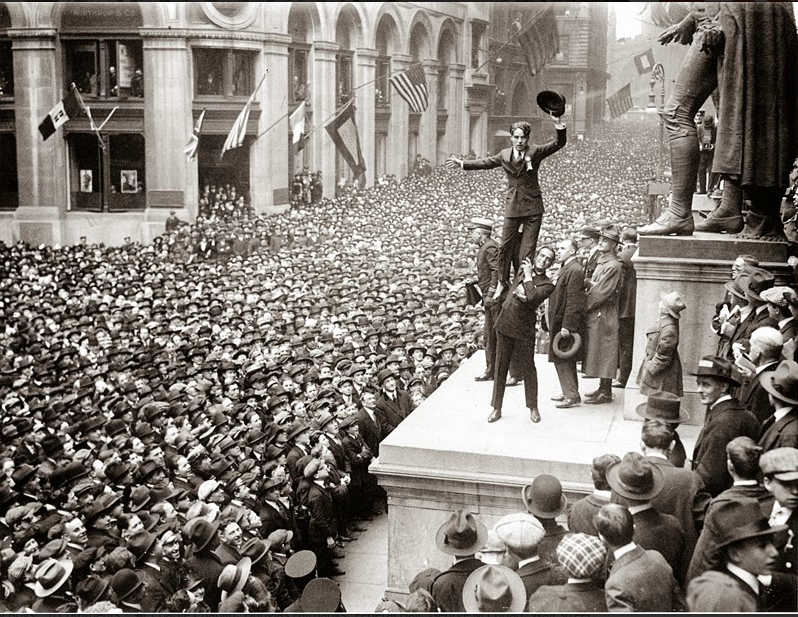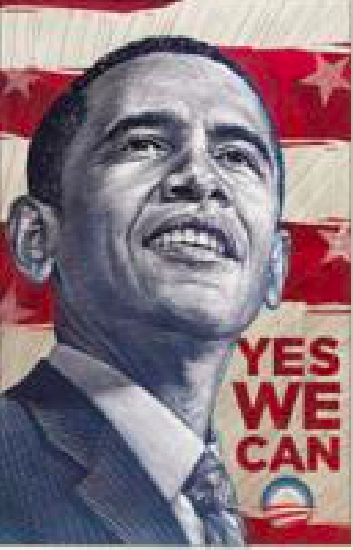
The CPI had a profound and lasting impact on the field of communications. The first propaganda committee of its kind in the world, it arguably created the field of public relations, and is credited with "pioneering the techniques of manipulating and managing public opinion based on the theories of mass psychology." - "Liberty Bonds," Federal Reserve History (4 Dec. 2015) [1]

"Charlie Chaplin and Douglas Fairbanks at Wall Street Bond Rally.” The New York Times Photo Archive, 9 April 1918.
Wilson and the CPI's highly effective use of mass multimedia has been used continually by government leaders, including Hitler in WWII, Franklin Delano Roosevelt’s radio Fireside Chats, and Donald Trump’s Twitter bombardments. "[The CPI was] the first and only time the United States government had a ministry of propaganda…But the CPI endured as a blueprint for the information state that exists today in peacetime as well as during war…Propaganda in all its manifestations—both the provision and suppression of information—is a quotidian feature of American government." - John Maxwell Hamilton, Manipulating the Masses (2020) [2]
Corporations and politicians mirror these mass communication techniques to gain consumer loyalty. Echoes of Four Minute Men speeches are seen today in celebrity public service announcements, commercials, and political
ads. Military recruitment advertisements are video versions of CPI posters appealing to patriotic emotions. Opinion-based websites and magazine "advertorials" are like the CPI press releases disguised as news articles. The CPI tactic of saturating its audience through unrelenting repetition and short, snappy slogans like "Uncle Sam Wants YOU" is echoed in Obama’s "Yes We Can" and Trump’s "Make America Great Again." Dissent the CPI called "enemy talk" is today dismissed as "fake news." Government denouncements of WWI’s "Huns" that led to discrimination of ethnic Germans are seen today in the anti-ethnic Asian discrimination triggered by coronavirus blame tactics.

"Yes We Can (Obama Campaign Poster)." Museum of Fine Arts Boston, 2008.

“Donald Trump For President 2016 Campaign Posters.” Lori Ferber Presidential Collections, 2016.
Along with its positive and negative lessons, the CPI also serves as a warning about how government pressure can make media organizations relax independent standards. It reminds the press and the people to fact check, carefully consider sources, and protect First Amendment rights even in wartime.
"The American people may pardon for a time the suppression of news. It is conceivable that the safety of our land and sea forces may demand certain reticence. But Americans will never pardon expanded, adorned, exaggerated, and untruthful accounts of conflicts in which our forces may be engaged. They do not want to be put into the humiliating and ridiculous position of rejoicing over great victories never achieved, of exulting over the defeat of the enemy 'in force' when the affair described is one of the ordinary incidents of the transatlantic navigation."
- "The Committee on Public Misinformation," The New York Times (1917) [3]
Today as we see history repeating with propaganda in mass media, fake news, and brainwashing people into embracing false claims through repetition, remember the caution of Senator Hiram Johnson in 1917 [4]:
"The first casualty when war comes is truth."
Header image: "George Creel and President Woodrow Wilson.” Getty Images, 1919.
[1] “Liberty Bonds.” Federal Reserve History, 4 Dec. 2015.
[2] Maxwell, John Hamilton. "Manipulating the Masses." Louisiana State University Press, 2020.
[3] Ponder, Stephen. “The Committee on Public Misinformation.” The New York Times, 4 Feb. 1918.
[4] Knightley, Phillip. The First Casualty: The War Correspondent as Hero and Myth-Maker from the Crimea to Iraq. John Hopkins University Press, 5 Oct. 2004.